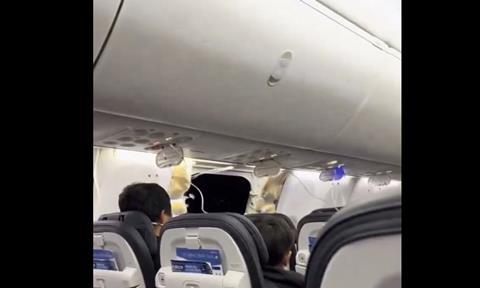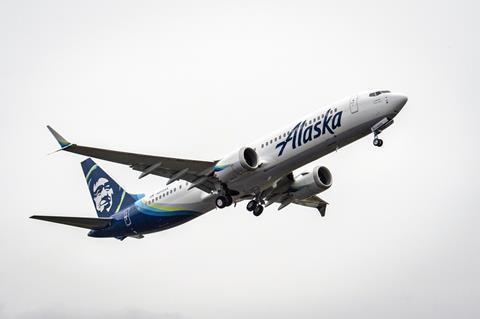The National Transportation Safety Board (NTSB) has sent a “go team” to Portland to investigate a dramatic incident that left a gaping hole in the side of an Alaska Airlines Boeing 737 Max 9.
Still unclear is how other airlines or US regulators will respond to the 5 January event, which has already prompted Alaska to ground all 65 of its Max 9s.
Airlines globally operate 215 Max 9s, according to Cirium data. United Airlines has the largest fleet, with 79 of the jets in service. Other sizeable operators include Copa Airlines, with 29 Max 9s, and Aeromexico, with a 19-strong fleet, data shows.

Those airlines have not responded to questions from FlightGlobal about what actions they intend to take in response to the Alaska incident.
“[The] NTSB has launched a go-team to Portland, Oregon to investigate an event with a [Max 9] during a flight from Portland to Ontario, California. No serious injuries were reported,” the NTSB says.
Its team will arrive in Portland today and consists of board chair Jennifer Homendy and “experts in structures, operations and systems”, the safety investigatory agency adds. It says the team will likely provide an on-scene briefing after arriving.
The incident involved an Alaska 737 Max 9 (registration N704AL) operating flight 1282.
Shortly after taking off at 17:06 local time, the jet suffered a fuselage failure. Images taken from the cabin show a large hole in the side of the jet, which had reached about 16,000ft before the pilots made an emergency decent.
They returned to Portland landed safely. “No serious injuries were reported,” the NTSB says.

Media reports have said the missing fuselage section included an unused mid-cabin emergency exit. That exit had reportedly been de-activated, making it unusable. Alaska outfits its Max 9s with 178 seats – far fewer than the type’s maximum 220-seat configuration – meaning the airline can decommission the mid-cabin emergency exits.
“We have decided to take the precautionary step of temporarily grounding our fleet of 65 Boeing Max 9 aircraft,” Alaska said following the incident. “Each aircraft will be returned to service only after completion of full maintenance and safety inspections,” which are to be completed in the next few days.
It remains unclear how other airlines might respond to the incident. Eleven airlines globally operate 215 in-service Max 9s, Cirium shows. Many of those aircraft have reduced seat counts – layouts similar to Alaska’s – but it is unclear how many of the jets have plugged mid-cabin emergency exits.
The FAA said on 5 January that it is investigating but has not issued more information.
Boeing says it is ready to assist with the investigation but has not elaborated.
The US manufacturer has faced repeated, ongoing challenges with its 737 Max programme. Those have included a string of recent quality problems and production troubles.
Boeing has been seeking to get the Max programme back on track after regulators grounded the type for 20 months following two Max 8 crashes, in 2018 and 2019.


























